Computational Model to Evaluate the Effect of Passive Techniques in Tube-In-Tube Helical Heat Exchanger
Abstract
:1. Introduction
2. Methodology
2.1. Modeling of Heat Exchanger
2.2. Numerical Computation
3. Results and Discussion
4. Conclusions
- The numerical model of [13] was reproduced considering the assumptions and experimental information described in that research. This evidence gives confidence about the evaluation when the passive techniques were added.
- With reference to the first passive technique applied the addition of four ridges in the inner tube. Shows an increment up to 28.8% in the Nusselt number were calculated for all cases under study. Then, when the Dean number increased from 4500 to 6000 the Nusselt number increases linearly. This increment can be caused by the velocity contours generated by the addiction of ridges and its influence on heat transfer. In the annular section of heat exchanger, the ridges decrease the centrifugal forces generated by the action of a helical coil.
- When the twist of the internal tube was added from one to three turns, an increase up to 3% in the Nusselt number was calculated. The biggest increase, up to 9% was calculated when five turns were simulated.
- The numerical results of this research will be considered to design other passive techniques without twist in tube. The previous suggestion is supported by the increase in the heat transfer, this work assumes that there is no compromise in the mechanical integrity of the tubes caused by twist.
Author Contributions
Funding
Conflicts of Interest
References
- Li, P.; Liu, Z.; Liu, W.; Chen, G. Numerical study on heat transfer enhancement characteristics of tube inserted with centrally hollow narrow twisted tapes. Int. J. Heat Mass Transf. 2015, 88, 481–491. [Google Scholar] [CrossRef]
- Pan, C.; Zhou, Y.; Wang, J. CFD study of heat transfer for oscillating flow in helically coiled tube heat-exchanger. Comput. Chem. Eng. 2014, 69, 59–65. [Google Scholar] [CrossRef]
- Dean, W.R. XVI. Note on the motion of fluid in a curved pipe. Lond. Edinb. Dublin Philos. Mag. J. Sci. 1927, 4, 208–223. [Google Scholar] [CrossRef]
- Kurnia, J.C.; Sasmito, A.P.; Akhtar, S.; Shamim, T.; Mujumdar, A.S. Numerical Investigation of Heat Transfer Performance of Various Coiled Square Tubes for Heat Exchanger Application. Energy Procedia 2015, 75, 3168–3173. [Google Scholar] [CrossRef] [Green Version]
- García, A.; Solano, J.P.; Vicente, P.G.; Viedma, A. The influence of artificial roughness shape on heat transfer enhancement: Corrugated tubes, dimpled tubes and wire coils. Appl. Therm. Eng. 2012, 35, 196–201. [Google Scholar] [CrossRef]
- Rainieri, S.; Bozzoli, F.; Pagliarini, G. Experimental investigation on the convective heat transfer in straight and coiled corrugated tubes for highly viscous fluids: Preliminary results. Int. J. Heat Mass Transf. 2012, 55, 498–504. [Google Scholar] [CrossRef]
- Zachár, A. Analysis of coiled-tube heat exchangers to improve heat transfer rate with spirally corrugated wall. Int. J. Heat Mass Transf. 2010, 53, 3928–3939. [Google Scholar] [CrossRef]
- Salpingidou, C.; Misirlis, D.; Vlahostergios, Z.; Flourous, M.; Donnerhack, S.; Yakinthos, K. Numerical modeling of heat exchangers in gas turbine using CFD computations and thermodynamic cycle analysis tools. Chem. Eng. Trans. 2016, 52, 517–522. [Google Scholar]
- Bakosova, M.; Oravec, J.; Vasickaninova, A.; Meszaros, A. Neural-network-based and robust model-based predictive control of a tubular heat exchanger. Chem. Eng. Trans. 2017, 61, 301–306. [Google Scholar]
- Yang, X.; Xiong, T.; Dong, J.L.; Li, W.X.; Wang, Y. Investigation of the dynamic melting process in a thermal energy storage unit using a helical coil heat exchanger. Energies 2017, 10, 1129. [Google Scholar] [CrossRef]
- Sharifi, K.; Sabeti, M.; Rafiei, M.; Mohammadi, A.H.; Shirazi, L. Computational fluid dynamics (CFD) technique to study the effects of helical wire inserts on heat transfer and pressure drop in a double pipe heat exchanger. Appl. Therm. Eng. 2018, 128, 898–910. [Google Scholar] [CrossRef]
- Ju-Lee, H.; Ryu, J.; Hyuk-Lee, S. Influence of Perforated Fin on Flow Characteristics and Thermal Performance in Spiral Finned-Tube Heat Exchanger. Energies 2019, 12, 556. [Google Scholar] [CrossRef]
- Kumar, V.; Saini, S.; Sharma, M.; Nigam, K.D.P. Pressure drop and heat transfer study in tube-in-tube helical heat exchanger. Chem. Eng. Sci. 2006, 61, 4403–4416. [Google Scholar] [CrossRef]
- Valdés-Ortiz, M.; Ardila-Marin, J.G.; Martínez-Pérez, A.F.; Betancur Gómez, J.D. Via ANSYS Numerical Analysis of Heat Exchangers with Passive Improvement: Case Study Meshing Density and Turbulence Model. Rev. CINTEX 2017, 22, 59–68. [Google Scholar]
- Launder, B.E.; Spalding, D.B. The numerical computation of turbulent flows. Comput. Methods Appl. Mech. Eng. 1974, 3, 269–289. [Google Scholar] [CrossRef]

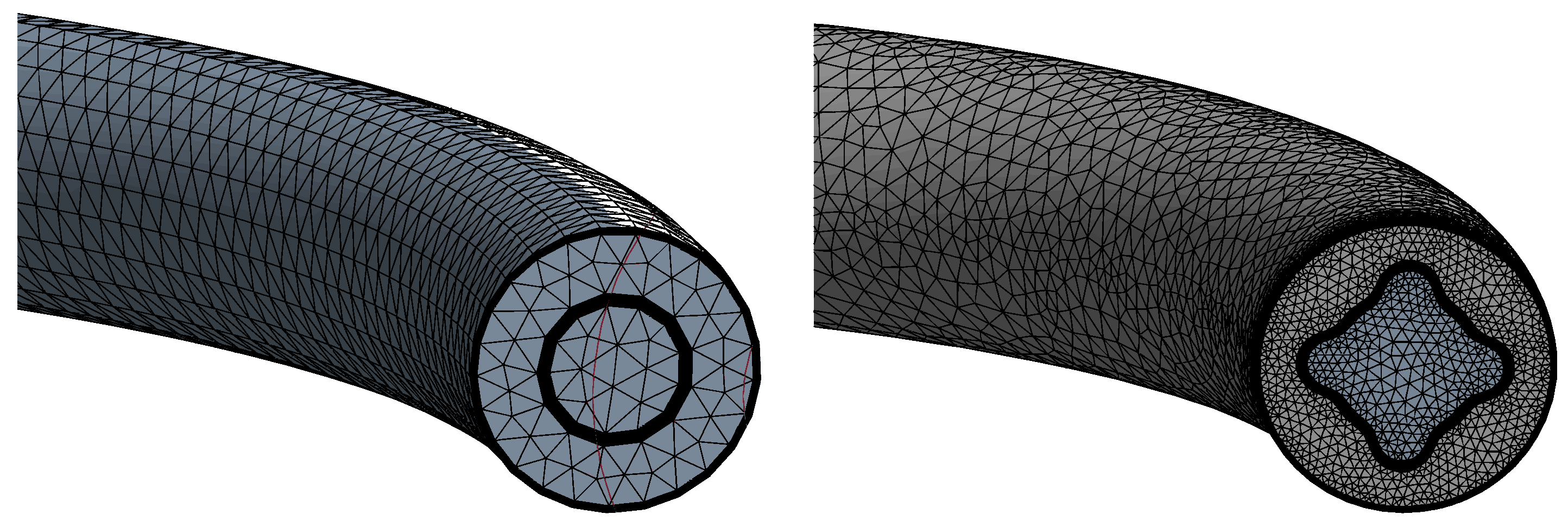


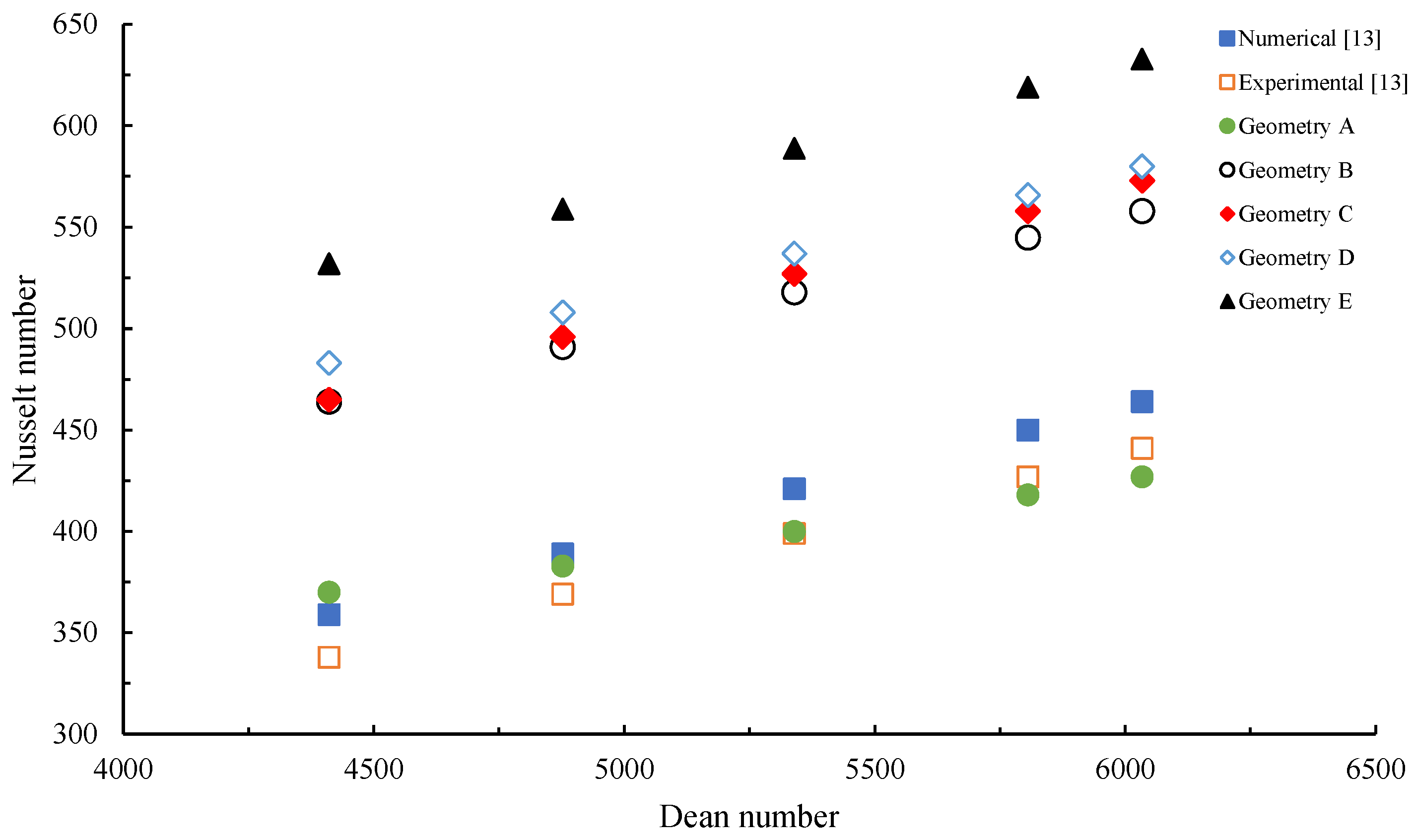


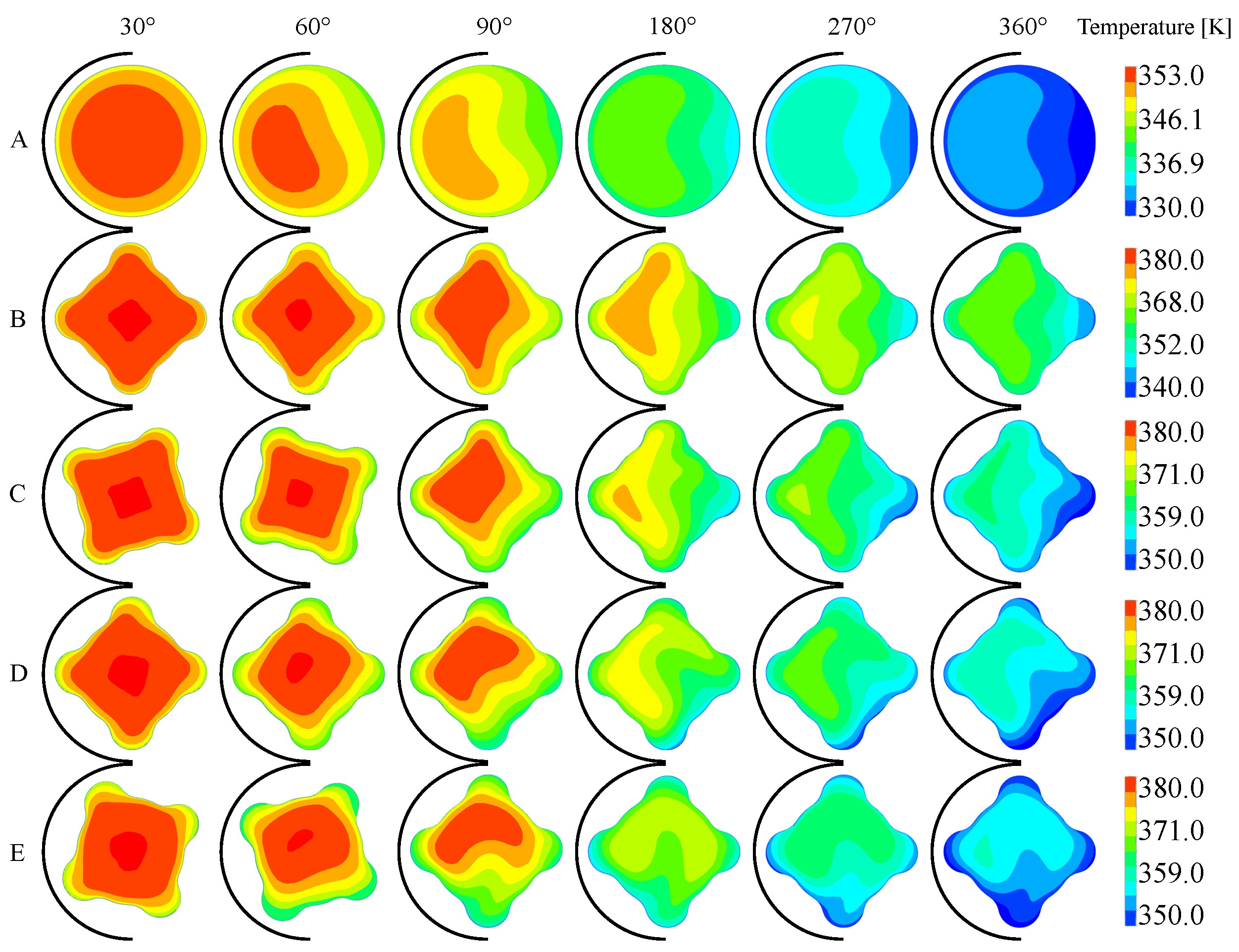
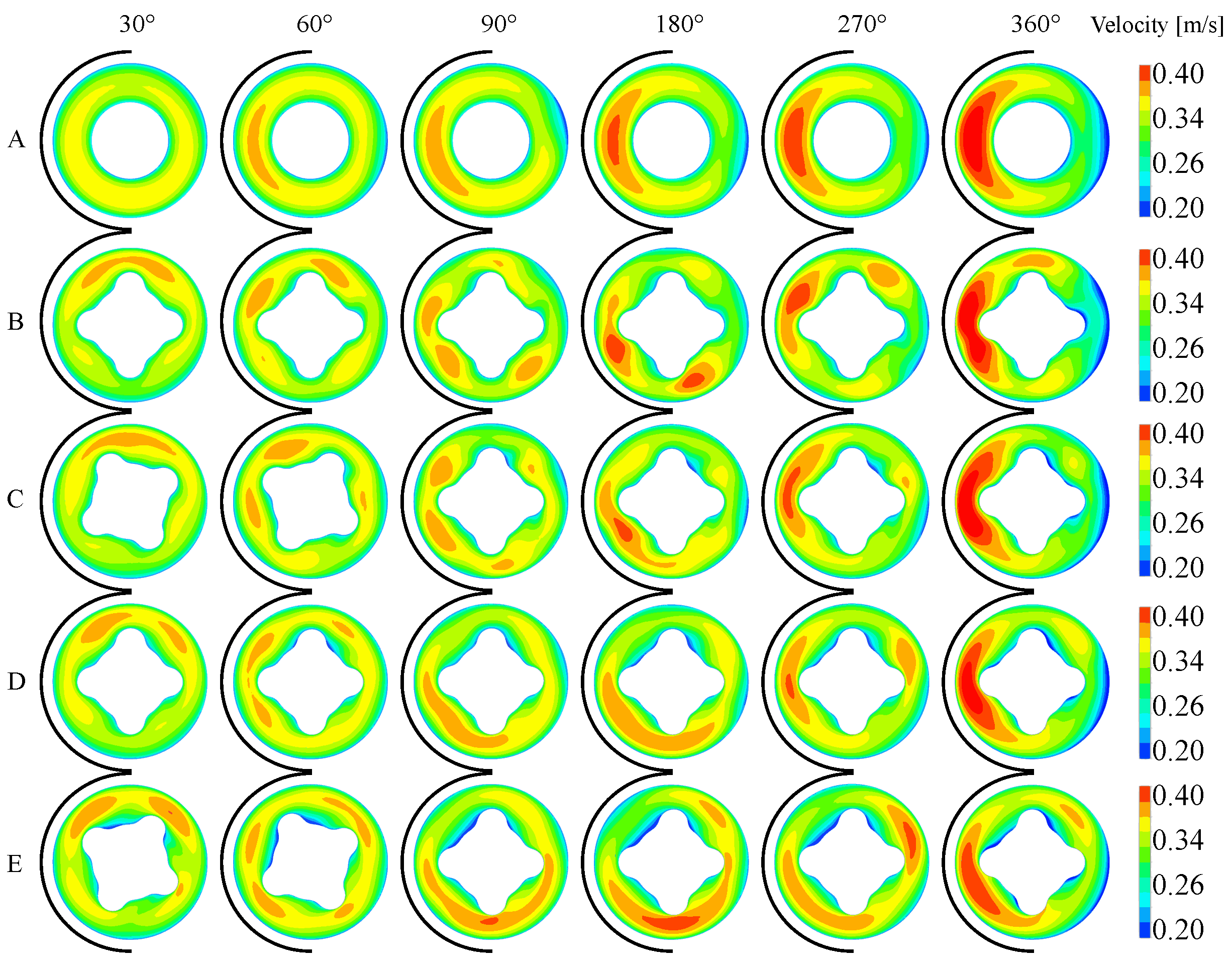
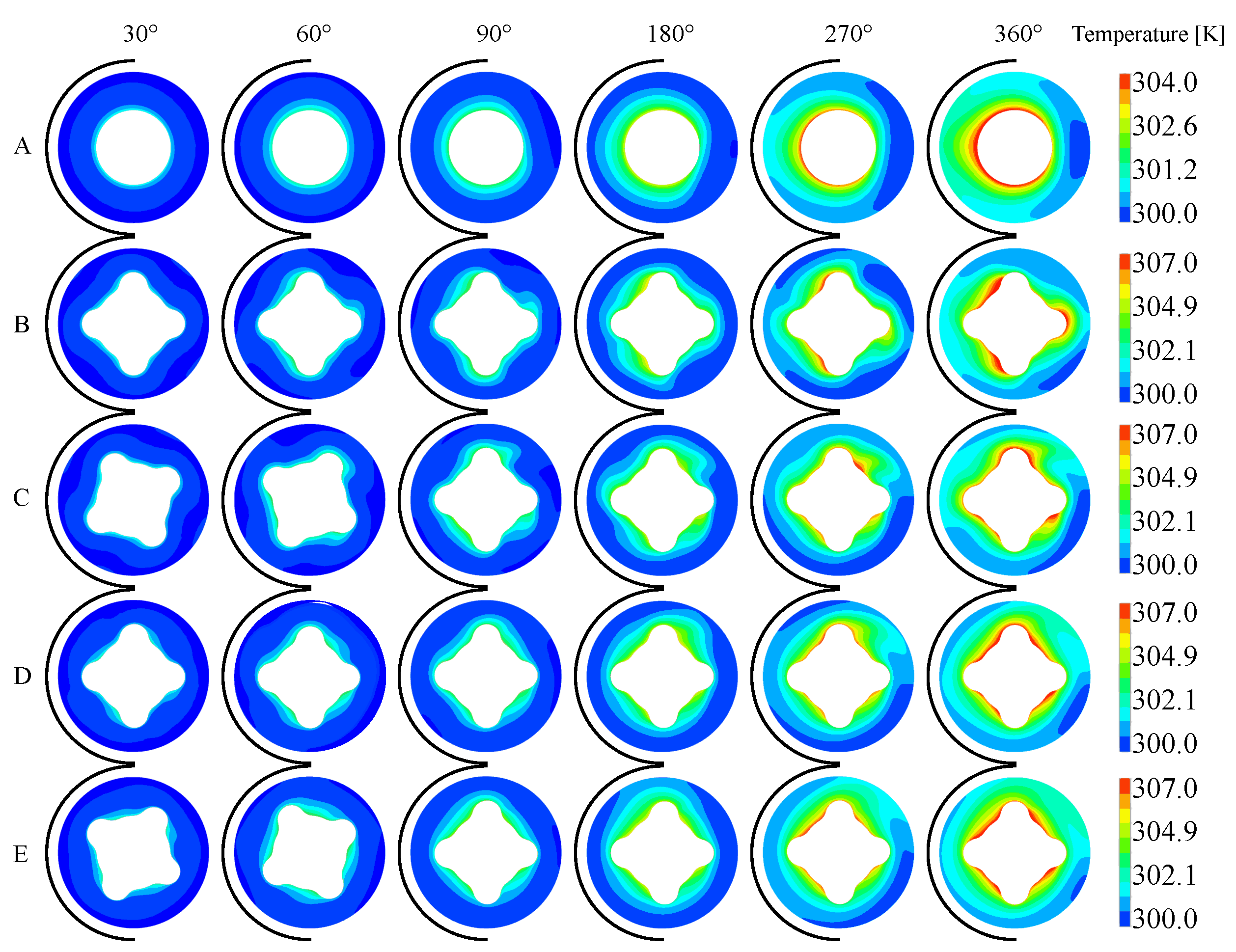
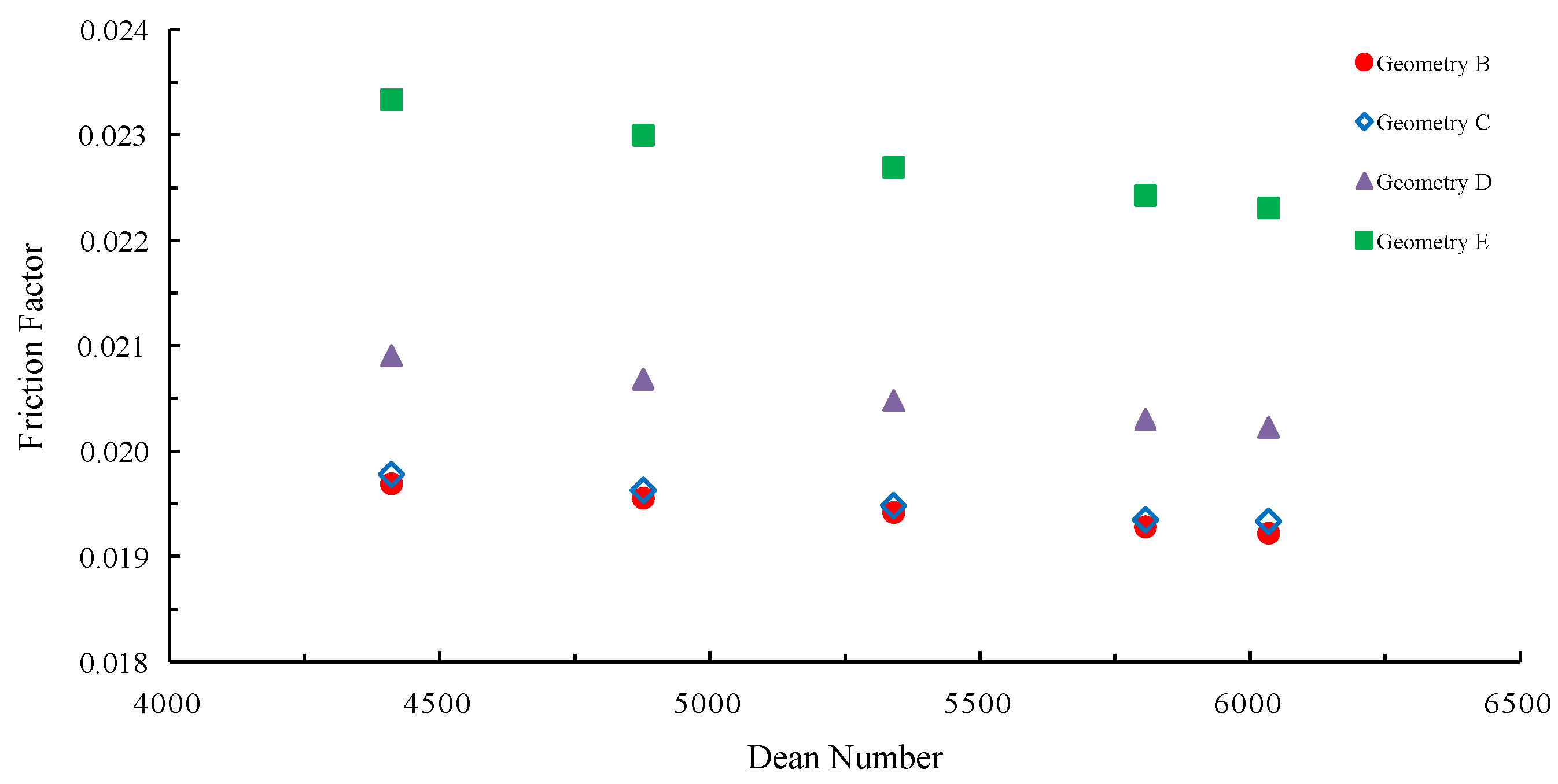
| Geometry and Boundary Conditions | Internal Tube | External Tube |
|---|---|---|
| Outer diameter (m) | 0.0254 | 0.0508 |
| Helical diameter (m) | 0.762 | 0.762 |
| Pitch (m) | 0.1 | 0.1 |
| Velocity (m/s) | 0.073 | 0.32–0.44 |
| Dean number (dimensionless) | 1000 | 4410–6030 |
| Prandtl number (dimensionless) | 7 | 7 |
| Geometry | Passive Modification |
|---|---|
| A | tube-in-tube |
| B | four ridges without twist |
| C | four ridges with 1 twist |
| D | four ridges with 3 twist |
| E | four ridges with 5 twist |
© 2019 by the authors. Licensee MDPI, Basel, Switzerland. This article is an open access article distributed under the terms and conditions of the Creative Commons Attribution (CC BY) license (http://creativecommons.org/licenses/by/4.0/).
Share and Cite
Valdes, M.; Ardila, J.G.; Colorado, D.; Escobedo-Trujillo, B.A. Computational Model to Evaluate the Effect of Passive Techniques in Tube-In-Tube Helical Heat Exchanger. Energies 2019, 12, 1912. https://doi.org/10.3390/en12101912
Valdes M, Ardila JG, Colorado D, Escobedo-Trujillo BA. Computational Model to Evaluate the Effect of Passive Techniques in Tube-In-Tube Helical Heat Exchanger. Energies. 2019; 12(10):1912. https://doi.org/10.3390/en12101912
Chicago/Turabian StyleValdes, Miyer, Juan G. Ardila, Dario Colorado, and Beatris A. Escobedo-Trujillo. 2019. "Computational Model to Evaluate the Effect of Passive Techniques in Tube-In-Tube Helical Heat Exchanger" Energies 12, no. 10: 1912. https://doi.org/10.3390/en12101912





